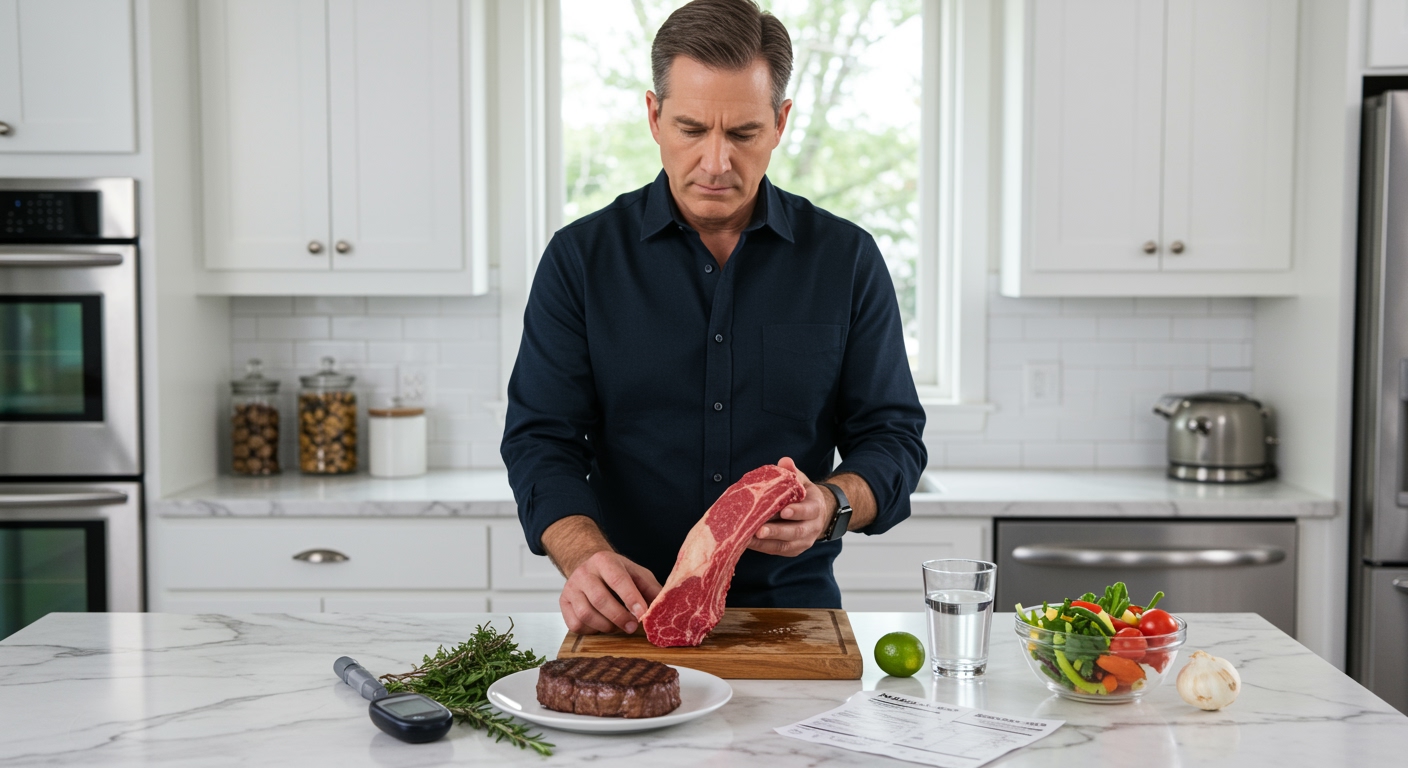✪ Key Takeaway: Steak has zero carbs and won’t spike blood sugar, but processed meats increase diabetes risk by 15%.
Introduction
You walk into your favorite steakhouse and suddenly freeze.
That juicy ribeye looks amazing, but you wonder if it will send your blood sugar through the roof.
Hi, I’m Abdur, your nutrition coach, and today I’m going to explain exactly how steak affects your diabetes and what you need to know to make smart choices.
Does Steak Raise Blood Sugar Levels?
Here’s the surprising truth about steak and blood sugar.
Pure steak contains zero carbohydrates, which means it has a glycemic index of zero.
Your blood sugar levels remain stable when you eat plain steak without any added sugars or marinades.
The protein and fat content in steak actually helps slow down the absorption of any carbohydrates you eat with your meal.
This means steak can actually help prevent blood sugar spikes when paired with other foods.
However, the way you prepare your steak makes a huge difference in how it affects your diabetes management.
✪ Fact: A 6-ounce sirloin steak contains 54 grams of protein and zero grams of carbohydrates.
What About Long-Term Diabetes Risk?
The relationship between steak and diabetes becomes more complex when we look at long-term health effects.
Research from Cambridge University shows that eating processed red meat increases your risk of developing type 2 diabetes by 15%.
But here’s what most people miss: this research focuses on processed meats like bacon, sausages, and deli meats.
Fresh, unprocessed steak shows a much smaller association with diabetes risk compared to processed varieties.
The nitrates, preservatives, and excess sodium in processed meats appear to be the main culprits behind increased diabetes risk.
Your body handles fresh steak very differently than it handles a hot dog or bacon.
The key lies in choosing high-quality, minimally processed cuts and preparing them without adding sugar-laden sauces or marinades.
✪ Pro Tip: Choose grass-fed beef when possible as it contains higher levels of omega-3 fatty acids.
How Should You Prepare Steak For Diabetes?
The preparation method can make or break your diabetes-friendly steak meal.
Grilling, broiling, or pan-searing without added oils keeps your steak healthy and blood sugar stable.
Avoid marinades that contain brown sugar, honey, or high-fructose corn syrup as these will add unnecessary carbohydrates.
Instead, season your steak with herbs, spices, garlic, and lemon juice for maximum flavor without the blood sugar impact.
The cooking temperature matters too because well-done meat produces more advanced glycation end products (AGEs).
These compounds can increase inflammation and insulin resistance over time.
Aim for medium-rare to medium doneness to minimize AGE formation while ensuring food safety.
✪ Note: Marinating steak in acidic ingredients like vinegar can reduce AGE formation by up to 50%.
What’s The Best Portion Size For Diabetics?
Portion control becomes crucial when you have diabetes, even with zero-carb foods like steak.
A 3 to 4-ounce serving of steak provides adequate protein without overwhelming your digestive system.
This portion size equals roughly the size of your palm or a deck of cards.
Eating larger portions can trigger gluconeogenesis, a process where your liver converts excess protein into glucose.
This process happens slowly and won’t cause immediate blood sugar spikes, but it can affect your overall glucose control.
Balance your steak with non-starchy vegetables like broccoli, asparagus, or a mixed green salad.
This combination provides fiber that further helps stabilize blood sugar and keeps you satisfied longer.
✪ Pro Tip: Eat your vegetables first to slow down protein digestion and improve satiety signals.
Which Cuts Work Best For Blood Sugar Control?
Not all steaks are created equal when it comes to diabetes management.
Lean cuts like sirloin, tenderloin, and eye of round provide high-quality protein with less saturated fat.
These cuts help maintain stable insulin sensitivity compared to fattier options.
Fattier cuts like ribeye and T-bone taste amazing but contain more saturated fat, which can worsen insulin resistance over time.
However, you don’t need to avoid them completely if you enjoy them occasionally and keep portions reasonable.
The quality of the beef matters more than the specific cut in many cases.
Grass-fed beef contains more anti-inflammatory omega-3 fatty acids and conjugated linoleic acid (CLA) compared to grain-fed varieties.
✪ Fact: Grass-fed beef contains 2-3 times more omega-3 fatty acids than conventional grain-fed beef.
The Bottom Line
Steak can absolutely fit into a diabetes-friendly eating plan when you choose the right cuts and prepare them properly.
Quality trumps quantity every single time when it comes to managing your health through food choices.
I’d love to hear about your experiences with steak and diabetes management, so please share your thoughts, questions, or favorite preparation methods in the comments below.
References
At NutritionCrown, we use quality and credible sources to ensure our content is accurate and trustworthy. Below are the sources referenced in creating this article:
- Cambridge University: Red and processed meat consumption associated with higher type 2 diabetes risk
- Harvard School of Public Health: Red meat consumption associated with increased type 2 diabetes risk
- Diabetes Canada: Glycemic Index Food Guide
- January AI: Glycemic Index of Steak





